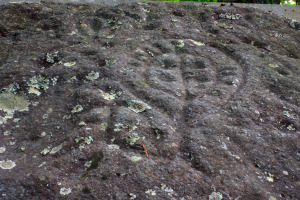Around the country, National Forests are protecting more than trees. Historical places, grasslands, geological formations and more are scattered across the country. In the Chatthoochee-Oconee National Forest in northern Georgia, petroglyphs at Track Rock Gap provide visitors with a sense of mystery and a window into the past. More than one hundred symbols cover six table-sized soapstone boulders in the gap between Thuderstruck Mountain and Buzzard Roost Ridge.

Native Americans used one of two techniques to carve into the rocks: pecking or incising. To peck into the stone, they used hard rocks, or hammer stones, to make the shapes with repeated blows in the same spot until the design was created. For incising, the carver rubbed a hard stone back and forth to create the design. Soapstone is a relatively soft metamorphic rock that was commonly used for dishes and stoves because it absorbs and distributes heat evenly.
The public and research communities have long known about the petroglyphs at Track Rock Gap, but it wasn’t until 2009 that researchers completed the first study of the site. Led by archaeologist Johannes Loubser, scientists used a variety of methods including tracing, nighttime photography and halogen lighting to best record and study these ancient carvings.
In addition to recording the carvings, researchers are trying to figure out who made the petroglyphs and why. These answers are complicated, since many groups overlapped in the Blue Ridge Mountain region of North Georgia, the Carolinas and Tennessee. The area was largely dominated by Cherokee, but Creek and Catabwa also frequented the mountains. Many researchers believe that no single group made the carvings, but that many different groups added to Track Rock throughout history. Due to similarities in social structure, economic and political systems, religious practices and linguistics, all three groups could have easily contributed to the carvings.
Even if the Cherokee didn’t carve the designs, although it is likely they did, they still have a name for Track Rock Gap: Datsu’nalsagun’yi, “where there are tracks” and Degayeelun’ha “printed (branded) place.”
When You Go: Track Rock Gap, two hours north of Atlanta, is open to the public free of charge. To best see the carvings, examine the rocks either early or late in the day when the light is at a low angle. Be sure to visit the Chattahoochee-Oconee’s website to print out drawings of the petroglyphs , which will help you identify the figures while you’re there.

